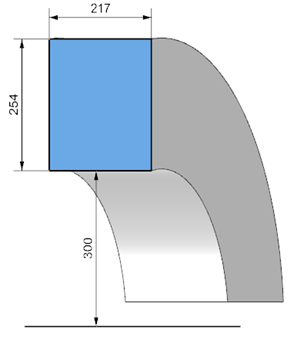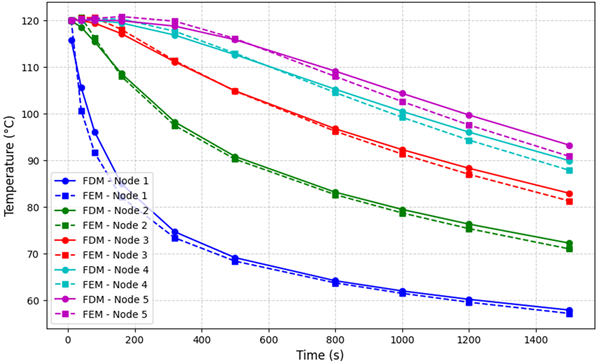VVT36 - Transient 2D heat transfer in a ring with conduction and radiation to environment
| Test case |
|---|
| SVTEST276 |
Description
The purpose of this test case is to validate transient heat flow in a 2D ring with a rectangular cross-section model due to heat conduction and surface radiation losses. Due to the limitations of analytical solutions under radiative boundary conditions, an in-house 1D model was developed that uses axisymmetric geometry to reduce the problem to a single spatial dimension. This model solves the unsteady heat conduction equation with the appropriate boundary conditions. It was first validated against several steady-state cases with known analytical solutions and then extended to transient scenarios. This validation case compares the results from the Simcenter 3D thermal solver with those from the validated 1D model.
Geometry
The ring with the rectangular cross-section is defined with an inner radius of 300 mm and an outer radius of 554 mm. The axisymmetric modeling technique is used, which requires sketching a 2D cross-sectional profile on the XZ plane and revolving it around the Z-axis. The rectangular cross-section, representing the ring wall, is 217 mm in length (axial direction) and 254 mm in height (radial direction).

Simulation model
A 2D mesh of axisymmetric linear triangle elements is generated on the surface of the plate, using a 48 mm element size.

The meshed elements have the following material and physical properties:
- Material: Steel
- Mass density: ρ = 7829 kg/m3
- Specific heat: Cp = 434 J/kg·K
- Thermal conductivity: k = 54 W/m·K
- Emissivity: ε = 1
The following boundary conditions are applied:
- Temperature constraint on the inner surface: T = 40 ºC
- Simple Radiation to Environment constraint on the outer surface.
This model uses the Simcenter 3D Multiphysics solver.
The following solution options are set:
- 2D Solid Option = ZX Plane, Z Axis
- Solution Type = Transient
- Radiative Environment Temperature of Tenv = 160 ºC
- Thermal Initial Temperature of T0 = 120 ºC
The following solution parameters are set:
- Solution Control: Element Discretization is set to Finite Element Method in the Thermal Solution Parameters modeling object.
Theory
The theoretical model is based on the 1D unsteady heat conduction equation in cylindrical coordinates, taking into account the balance between conductive and radiative heat transfer:
Radiation at the outer surface is treated as a nonlinear boundary condition:
where σ is the Stefan-Boltzmann constant of 5.67×10−8 W⋅m−2⋅K−4.
The transient heat conduction problem was solved using an in-house numerical code based on a 1D finite difference method (FDM) with explicit time integration.
Results
The following graph compares the temperature results predicted by the thermal solver using the finite element discretization method with those from the 1D model. The results are sampled from five different nodes at the right edge of the plate at 10s, 40s, 80s, 160s, 320s, 500s, 800s, 1200s, and 1500s.

The simulation results show good agreement with the numerical reference 1D solution.
